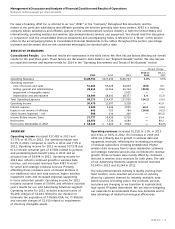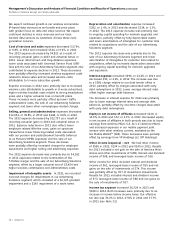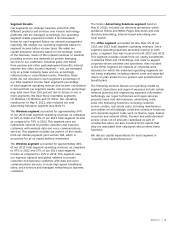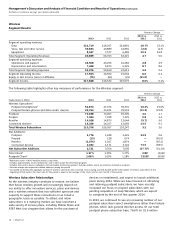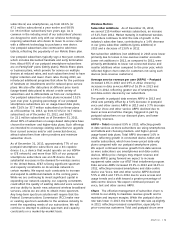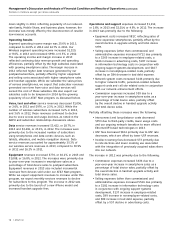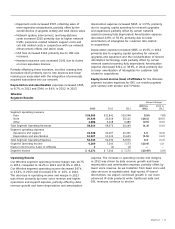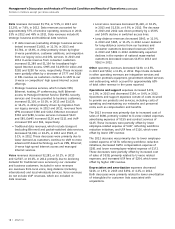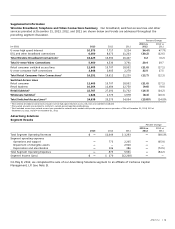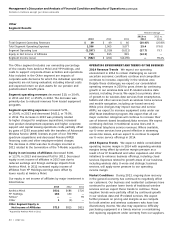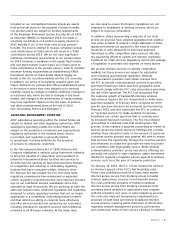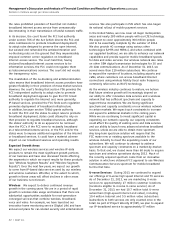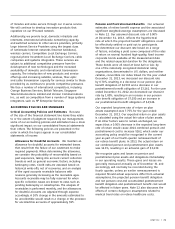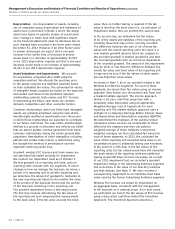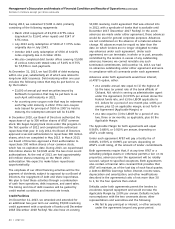AT&T Wireless 2013 Annual Report Download - page 23
Download and view the complete annual report
Please find page 23 of the 2013 AT&T Wireless annual report below. You can navigate through the pages in the report by either clicking on the pages listed below, or by using the keyword search tool below to find specific information within the annual report.
AT&T Inc. | 21
we also seek to ensure that legacy regulations are not
extended to broadband or wireless services, which are
subject to vigorous competition.
In addition, states representing a majority of our local
service access lines have adopted legislation that enables
new video entrants to acquire a single statewide or state-
approved franchise (as opposed to the need to acquire
hundreds or even thousands of municipal-approved
franchises) to offer competitive video services. We also
are supporting efforts to update and improve regulatory
treatment for retail services. Regulatory reform and passage
of legislation is uncertain and depends on many factors.
We provide wireless services in robustly competitive
markets, but those services are subject to substantial
and increasing governmental regulation. Wireless
communications providers must obtain licenses from
the FCC to provide communications services at specified
spectrum frequencies within specified geographic areas
and must comply with the FCC rules and policies governing
the use of the spectrum. The FCC has recognized that
the explosive growth of bandwidth-intensive wireless
data services requires the U.S. Government to make more
spectrum available. In February 2012, Congress set forth
specific spectrum blocks to be auctioned and licensed by
February 2015, and also authorized the FCC to conduct
an “incentive auction,” to make available for wireless
broadband use certain spectrum that is currently used
by broadcast television licensees. The FCC has initiated
proceedings to establish rules that would govern this
process. It also initiated a separate proceeding to review its
policies governing mobile spectrum holdings and consider
whether there should be limits on the amount of spectrum
a wireless service provider may possess. We seek to ensure
that we have the opportunity, through the incentive auction
and otherwise, to obtain the spectrum we need to provide
our customers with high-quality service. While wireless
communications providers’ prices and service offerings are
generally not subject to state regulation, states sometimes
attempt to regulate or legislate various aspects of wireless
services, such as in the area of consumer protection.
On January 14, 2014, the D.C. Circuit released its decision
on Verizon’s appeal of the FCC’s Net Neutrality rules.
Those rules prohibited providers of fixed, mass market
Internet access service from blocking access to lawful
content, applications, services or non-harmful devices.
The rules prohibited providers of mobile broadband
Internet access service from blocking consumers from
accessing lawful websites or applications that compete
with the provider’s own voice or video telephony services.
The rules also imposed transparency requirements on
providers of both fixed and mobile broadband Internet
access services, requiring public disclosure of information
regarding network management practices, performance
and commercial terms of their service offerings. In addition,
Included on our consolidated balance sheets are assets
held by benefit plans for the payment of future benefits.
Our pension plans are subject to funding requirements
of the Employee Retirement Income Security Act of 1974,
as amended (ERISA). In September 2013, we made a
voluntary contribution of a preferred equity interest in
AT&T Mobility II LLC to the trust used to pay pension
benefits. The trust is entitled to receive cumulative annual
cash distributions of $560, which will result in a $560
contribution during 2014. We do not have significant
additional contribution requirements to our pension plans
for 2014. However, a weakness in the equity, fixed income
and real asset markets could require us in future years to
make contributions to the pension plans in order to maintain
minimum funding requirements as established by ERISA.
Investment returns on these assets depend largely on
trends in the U.S. securities markets and the U.S. economy.
In addition, our policy of recognizing actuarial gains and
losses related to our pension and other postretirement plans
in the period in which they arise subjects us to earnings
volatility caused by changes in market conditions. Changes in
our discount rate, which are tied to changes in the bond
market, and changes in the performance of equity markets,
may have significant impacts on the fair value of pension
and other postretirement plans at the end of 2014
(see “Accounting Policies and Estimates”).
OPERATING ENVIRONMENT OVERVIEW
AT&T subsidiaries operating within the United States are
subject to federal and state regulatory authorities. AT&T
subsidiaries operating outside the United States are
subject to the jurisdiction of national and supranational
regulatory authorities in the markets where service
is provided, and regulation is generally limited
to operational licensing authority for the provision
of services to enterprise customers.
In the Telecommunications Act of 1996 (Telecom Act),
Congress established a national policy framework intended
to bring the benefits of competition and investment in
advanced telecommunications facilities and services to
all Americans by opening all telecommunications markets
to competition and reducing or eliminating regulatory
burdens that harm consumer welfare. However, since
the Telecom Act was passed, the FCC and some state
regulatory commissions have maintained or expanded
certain regulatory requirements that were imposed decades
ago on our traditional wireline subsidiaries when they
operated as legal monopolies. We are pursuing, at both the
state and federal levels, additional legislative and regulatory
measures to reduce regulatory burdens that are no longer
appropriate in a competitive telecommunications market
and that inhibit our ability to compete more effectively
and offer services wanted and needed by our customers,
including initiatives to transition services from traditional
networks to all IP-based networks. At the same time,


